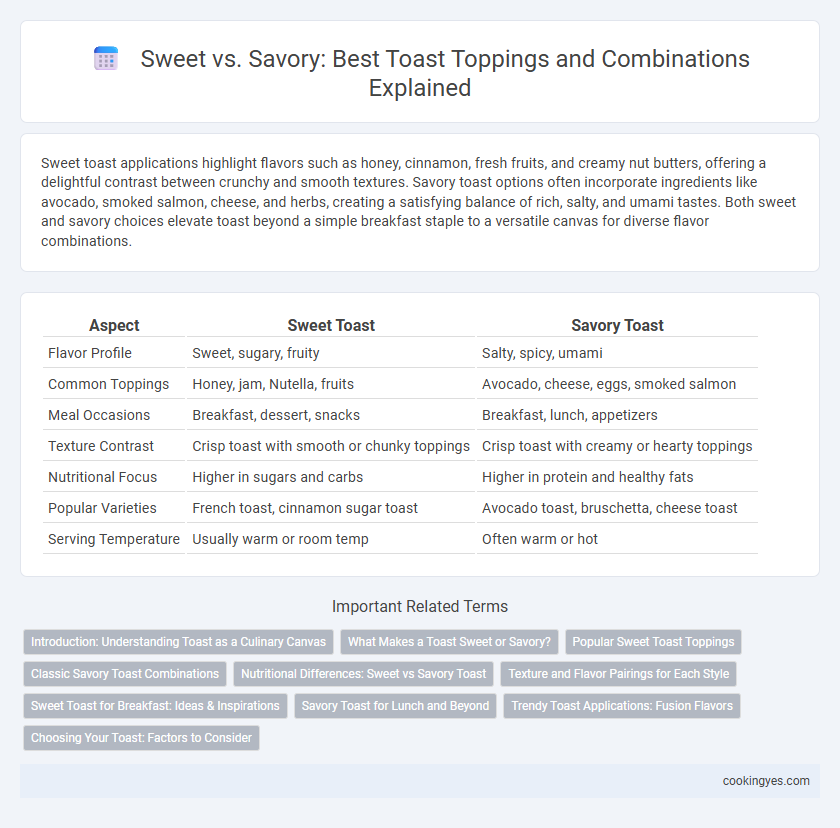Sweet toast applications highlight flavors such as honey, cinnamon, fresh fruits, and creamy nut butters, offering a delightful contrast between crunchy and smooth textures. Savory toast options often incorporate ingredients like avocado, smoked salmon, cheese, and herbs, creating a satisfying balance of rich, salty, and umami tastes. Both sweet and savory choices elevate toast beyond a simple breakfast staple to a versatile canvas for diverse flavor combinations.
Table of Comparison
| Aspect | Sweet Toast | Savory Toast |
|---|---|---|
| Flavor Profile | Sweet, sugary, fruity | Salty, spicy, umami |
| Common Toppings | Honey, jam, Nutella, fruits | Avocado, cheese, eggs, smoked salmon |
| Meal Occasions | Breakfast, dessert, snacks | Breakfast, lunch, appetizers |
| Texture Contrast | Crisp toast with smooth or chunky toppings | Crisp toast with creamy or hearty toppings |
| Nutritional Focus | Higher in sugars and carbs | Higher in protein and healthy fats |
| Popular Varieties | French toast, cinnamon sugar toast | Avocado toast, bruschetta, cheese toast |
| Serving Temperature | Usually warm or room temp | Often warm or hot |
Introduction: Understanding Toast as a Culinary Canvas
Toast serves as a versatile culinary canvas, offering a neutral base that enhances both sweet and savory toppings with its crispy texture and warm flavor profile. Its ability to absorb and complement diverse ingredients--from fruit preserves and honey to avocado and smoked salmon--makes toast a staple for innovative meal creations. Exploring sweet versus savory applications highlights toast's adaptability in balancing flavors and textures to satisfy varied palates.
What Makes a Toast Sweet or Savory?
A toast becomes sweet or savory based on the toppings and flavor profiles used. Sweet toasts typically feature ingredients like fruits, honey, jams, or sweet spreads such as Nutella, enhancing the bread with natural sugars and dessert-like flavors. Savory toasts rely on ingredients like cheese, avocado, eggs, herbs, and cured meats, providing umami and saltiness that create a satisfying meal or snack option.
Popular Sweet Toast Toppings
Popular sweet toast toppings include classic options like honey, maple syrup, and fruit preserves, which add natural sweetness and rich flavors. Nut butters such as almond and peanut butter combined with sliced bananas or berries create a nutrient-dense, satisfying breakfast or snack option. Sweet spreads like Nutella and cream cheese with a drizzle of agave or a sprinkle of cinnamon enhance texture and taste, appealing to those with a preference for indulgent, dessert-like toast applications.
Classic Savory Toast Combinations
Classic savory toast combinations often feature ingredients like avocado, tomato, and poached eggs, delivering a rich blend of textures and flavors. Savory toppings such as smoked salmon with cream cheese or sauteed mushrooms with garlic and herbs provide a hearty and satisfying option. These savory choices highlight umami and fresh, vibrant ingredients that pair perfectly with the crispness of toasted bread.
Nutritional Differences: Sweet vs Savory Toast
Sweet toast applications typically contain higher sugar content, contributing to increased calories and potential blood sugar spikes, while savory toast options often provide more protein and healthy fats from ingredients like avocado, eggs, or cheese. Nutritional differences also include fiber content, as sweet toasts with fruits or nut butters offer natural fibers, whereas savory toasts completed with vegetables can enhance vitamin and mineral intake. Choosing between sweet and savory toast depends on dietary goals such as managing energy levels, nutrient density, and glycemic response.
Texture and Flavor Pairings for Each Style
Sweet toast applications often feature creamy or crunchy toppings like honey, jam, or nut butters, creating a balanced texture contrast that enhances indulgence and sweetness. Savory toast styles emphasize crispy or chewy textures combined with umami-rich ingredients such as avocados, cheeses, or cured meats, delivering depth and complexity to each bite. Texture and flavor pairings in both sweet and savory toasts play a crucial role in achieving harmony and elevating the overall eating experience.
Sweet Toast for Breakfast: Ideas & Inspirations
Sweet toast for breakfast offers a delightful variety of flavors, combining fresh fruits like berries, bananas, and kiwi with spreads such as honey, almond butter, or cream cheese. Popular toppings include cinnamon sugar, nutella, and maple syrup, creating a perfect balance of sweetness and texture. This versatile option caters to healthy choices by incorporating chia seeds, Greek yogurt, or granola for added nutrition and crunch.
Savory Toast for Lunch and Beyond
Savory toast offers a versatile and nutritious option for lunch and beyond, featuring ingredients like avocado, smoked salmon, roasted vegetables, and various cheeses that provide balanced protein and healthy fats. Incorporating herbs, spices, and condiments such as hummus or pesto enhances flavor complexity and supports dietary variety. This savory approach elevates toast from a simple snack to a satisfying meal, suitable for diverse palates and dietary preferences.
Trendy Toast Applications: Fusion Flavors
Fusion flavors in toast applications blend sweet and savory elements to create innovative taste experiences, such as avocado toast topped with honey and chili flakes or ricotta paired with fig jam and prosciutto. Popular trend-driven combinations often feature global influences like miso and caramelized pineapple or spicy mango chutney with cream cheese. This inventive approach not only diversifies texture and flavor profiles but also appeals to adventurous palates seeking unique breakfast or snack options.
Choosing Your Toast: Factors to Consider
Choosing your toast involves balancing sweet and savory applications based on flavor profiles and meal timing. Sweet toast options like honey, jam, or cinnamon complement breakfast or dessert, while savory toast toppings such as avocado, cheese, or smoked salmon suit lunch and snacks. Considering texture, ingredient compatibility, and nutritional preferences helps optimize toast choices for satisfying and diverse culinary experiences.
Sweet vs Savory for Toast Applications Infographic

 cookingyes.com
cookingyes.com